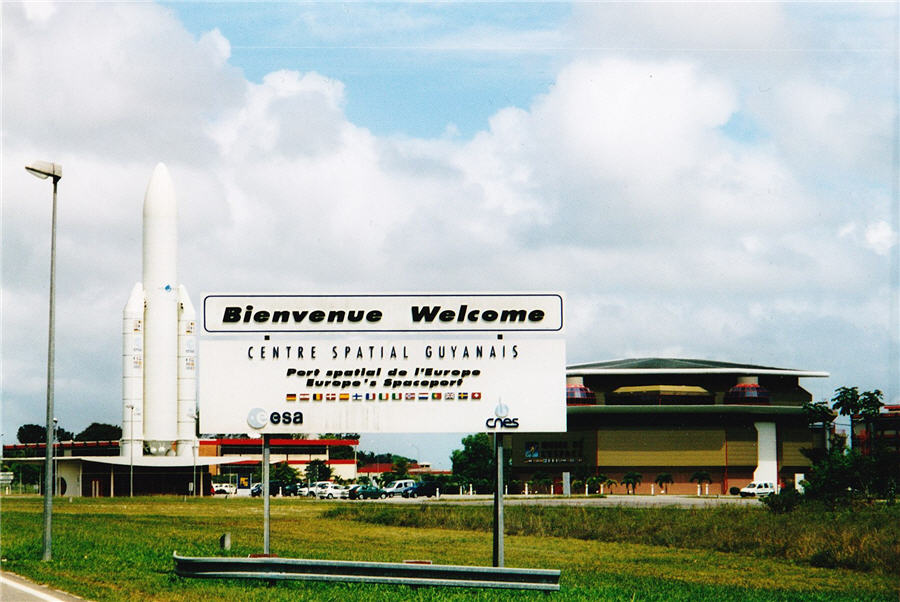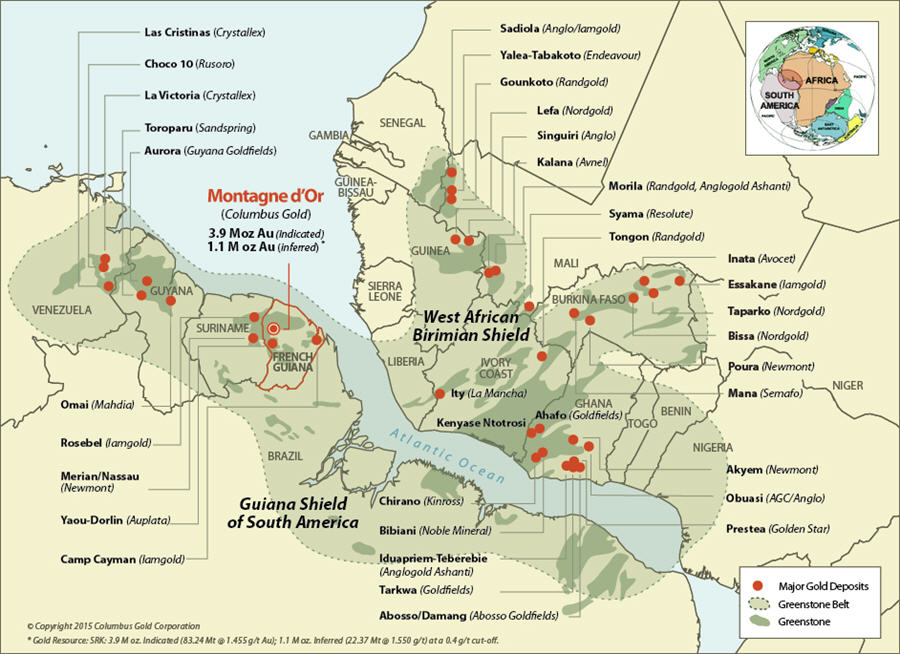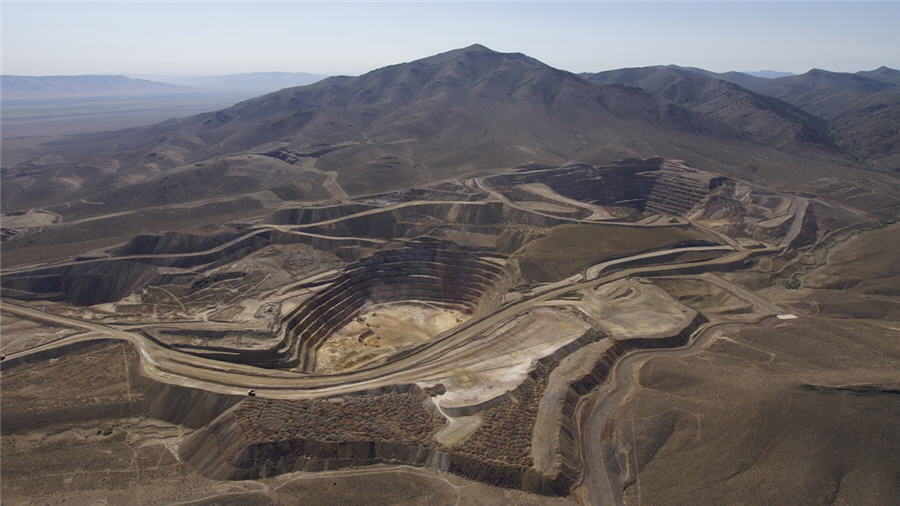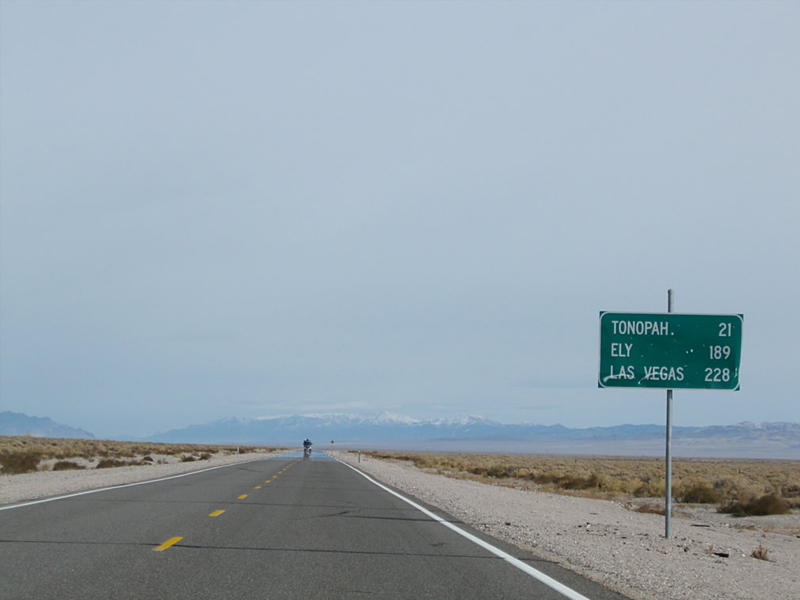As befits its location about 500 kilometres north of the equator, French Guiana is hot and humid, with average temperatures of 25-30 Celsius year-round. The namesake Cayenne pepper, named for the capital city, spices up cuisine and hints at the Creole roots of the territory, a region of France.
But it’s the heat being generated by a rising gold price that could help revitalize the economy of French Guiana. It’s a prosperous corner of South America, but GDP remains heavily reliant on the Guiana Space Centre. Selected in 1964 to be France’s space centre, the facility expanded to become Europe’s Spaceport in 1975 and is used by other countries launching satellites into space, including Russia.

The Guiana Space Centre. Photo: www.satellitetoday.com
Once you step off the space centre, however, incomes fall back to earth. French Guiana is heavily reliant on mainland France for subsidies, trade and goods. Traditionally, the region’s main industries have been fishing, logging and small-scale gold mining.
It’s gold that Vancouver entrepreneur Robert Giustra is eyeing. Specifically, the mountain of gold — Montagne d’Or — contained in the deposit that his Columbus Gold is advancing in the jungle 180 kilometres west of the capital city Cayenne. Gold miner Nordgold is earning in to a 50.01% interest in the project by spending at least US$30-million on exploration and delivering a bankable feasibility study by March 2017. In January Columbus sold an additional 5% interest in the project to Nordgold, so their interest would be 55.01% upon completion of the earn-in.
A mine like the one Columbus Gold is proposing would employ about 1,000 people during construction, 800 full-time during operations, and produce an average 270,000 ounces a year. With average mined grades of about 2 g/t in the first 10 years, it would be among the highest grade open-pit gold mines in the Americas.
For French Guiana, a large-scale commercial mine would be a game changer, diversifying the economy and boosting the French government’s tax take. It could even help the long-running battle against illegal gold miners in French Guiana. The mostly Brazilian “garimpeiros” use mercury to process the gold and cut a toxic path through the jungle, devastating the environment. The miners then vacate the country with their heavy equipment and the gold, leaving France to clean up the mess.
It’s a problem French authorities have grappled with for a long time, through regular sweeps and arrests. But the illegal miners have the edge through strength of numbers and an intimate knowledge of the jungle. All too often, crackdowns resemble a law enforcement version of arcade game Whac-A-Mole.
The path towards a gold mine at Montagne d’Or could well be a road to riches for shareholders of Columbus Gold, which is also drilling the Eastside gold exploration project in Nevada. Columbus has aggressively developed Montagne d’Or since picking up the project in 2011 when it had a 1.9-million-ounce resource (Inferred). Columbus has delineated 3.9 million ounces in the Indicated category and another 1.1 million ounces Inferred at grades well above global averages.
Last year the company published a preliminary economic assessment for Montagne d’Or showing positive economics at a gold price of US$1,200/oz:
Gold’s rise of more than 27% in 2016 should further improve economics in the Feasibility Study, and it’s not the only factor that will help. The PEA envisioned diesel power being generated on-site at a cost of about US.20/kWh. Columbus is now looking at connecting to the French Guiana grid, which would lower costs to .11-.12/kWh. It’s a substantial savings, since power is one of the mine’s largest operating costs.
In addition to improving economics at the flagship project, gold’s ascent to US$1,350 an ounce has increased the interest level in Columbus Gold shares. The company uplisted from the TSX Venture to the Toronto Stock Exchange on January 26, an accomplishment achieved by only one other company in the previous two years, and shares recently hit 93 cents, a 52-week high.
Sentiment has shifted dramatically from the bear market that took gold down from US$1,900 an ounce to below $1,100/oz, notes Giustra, Columbus’s Chairman and CEO. The resulting flight of capital

Robert Giustra, Columbus Gold Chairman and CEO
over the past four years led to liquidity drying up, wreaking havoc on the ability of junior mining firms to raise money and depressing share prices — even for companies with fundamental value. In order to initiate a position, funds would have to sell an existing holding, and there was nobody to sell to. It had the effect of putting the brakes on shares of all mining sector companies, including Columbus Gold. “People would love the story, but couldn’t buy the stock,” Giustra commented.
Capital and interest has returned to the sector, he says, and Columbus Gold shares should continue to benefit. The company has about $4 million in the treasury and two major catalysts on the horizon:
Exploration upside around the defined deposit has the potential of turning Montagne d’Or into something even bigger. The aggressive three-year timeline that Nordgold agreed to when it took on the project in March 2014 means little exploration work has been done. That’s despite indications the mineralization at Montagne d’Or remains open along strike to both the east and west, in parallel zones and untested nearby surface anomalies, as well as at depth.
The most recent exploration permits, granted in July by the French Minister of Economy, cover gold-soil anomalies two kilometres to the west and 2.7 kilometres to the east of the deposit. Only two holes have ever been drilled in these areas. One of them, punched in 750 metres east of the deposit, intercepted 31.94 g/t gold over 3.5 metres. Montagne d’Or is also open at depth below the 250 metres modelled by the pit.

Exploration permits on strike of the east and west extensions of Montagne d’Or
The Phase 1 exploration program kicks off in September with prospecting and soil sampling west of Montagne d’Or. For the second phase, Columbus may fly IP (induced polarization) to enhance drill targets. In the 1990s, such geophysical surveying helped trace the gold-sulphide mineralized horizons at Montagne d’Or.
The French geological survey identified the initial gold anomaly that defines Montagne d’Or in the 1990s. But the agency was subsequently privatized and began selling assets including Montagne d’Or, which saw very limited drilling in the late 1990s. Columbus Gold built the resource with drilling campaigns, but the aggressive three-year path to a bankable FS agreed to by Nordgold in March 2014 effectively put a cap on exploration drilling.
As a result, the highly prospective properties that surround Montagne d’Or are virtually virgin territory.
“French Guiana is extremely under-explored, particularly compared to its geological twin in the West African Birimian Shield,” Giustra says. “That gold region has seen over a century of exploration.”

Geological continuity between Guiana Shield and Birimian Shield
Having a deep-pocketed major pay the bills on flagship development project Montagne d’Or also helped Columbus Gold weather the bear market storms. Nordgold is the world’s 15th largest gold miner and operates 9 mines in 4 countries. In 2015, the Russia-based producer mined about 950,000 ounces at all-in sustaining costs of US$793 an ounce, making it one of the world’s lowest-cost producers. At 270,000 ounces a year, Montagne d’Or would be the largest mine Nordgold has an interest in.
Nordgold also has a reputation as an efficient and smart operator. The Russia-based miner built its newest mine, the 200,000-oz/yr Bissa gold mine in Burkina Faso, in just 15 months, Giustra points out. The company is also familiar with the geological neighbourhood because it operates three mines in the West African Birimian Shield — two in Burkina Faso, one in Guinea.
Nordgold was founded in 2007 as a division of Russian steel giant Severstal and went public on the London Stock Exchange in January 2012. The company is among the world’s fastest-growing gold miners, a feat accomplished mostly through acquisitions.
“People have said to me ‘Watch out for the Russians,’ ” Giustra says, “but they’ve been great partners. We come to agreements on a handshake and they follow through.”
Columbus Gold also has a growing Nevada exploration project to go with its Montagne d’Or development project in French Guiana. And the company’s foundation for growth lies under the desert sand at its Eastside project.
Nevada’s gold endowment is well-documented. The state produces about three-quarters of U.S. gold production and more than 6% of the world’s gold. Gold mines in the “Silver State” have been company makers for the world’s largest gold producers, including Barrick Gold and Newmont Mining — not to mention royalty giant Franco-Nevada.
Much of that production has come out of the Carlin Trend, one of the world’s richest gold endowments and home to Barrick and Newmont’s most prolific mines. The Carlin was discovered by legendary geologist John Livermore, who sparked a modern-day gold rush when he discovered a new kind of “invisible gold” mineralization in the early 1960s while working for Newmont. He founded Cordex Exploration in 1970 and went on to discover several Nevada gold mines. Livermore died in 2013.
Geologist Andy Wallace, Livermore’s longtime business partner, is now principal of Cordex Exploration as well as president of Columbus Gold Nevada. Wallace joined Cordex in 1974 at the height of the Nevada gold rush and became Cordex’s Manager of Exploration in 1985. He also has a few mine finds under his belt — under his leadership, Cordex discovered the 5-million-ounce Marigold deposit and the 12-million-ounce Stonehouse/Lone Tree deposits. Silver Standard purchased Marigold from Goldcorp and Barrick in 2014 and Lone Tree is still being mined by Newmont.

Columbus Gold Nevada President Andy Wallace is credited with discovering Marigold, now a Silver Standard mine.
Nevada is elephant country for gold. In Cordex, Columbus has an elephant hunter on its team. Columbus has an exclusive exploration arrangement with Cordex, giving the company one of the largest databases in Nevada. Cordex also runs Columbus’s exploration programs in Nevada.
Exploration is now focused on the Eastside project, composed of 725 mining claims making up 57.7 square kilometres about 32 kilometres west of Tonopah, Nevada. The nearby Round Mountain gold mine, which has produced more than 12 million ounces and is now 100% owned by Kinross, is about 32 km away. It’s the world’s largest heap-leach operation.
Columbus recently wrapped up its 2016 drill program at Eastside, completing 17,500 metres of drilling– 12,663 metres of reverse circulation and 4,837 metres of diamond drilling. The company has now drilled more than 37,000 metres at Eastside, mostly confined to a one-square-km parcel dubbed the “Original Target.” Columbus is aiming to complete a maiden resource estimate in the fall. Results year-to-date have been positive, with recent intercepts of 97.5 metres of 0.68 g/t gold and 13 metres of 1.12 g/t. Previous hits included 35.1 metres of 4.1 g/t and 152.4 metres of 0.71 g/t.
Gold and silver mineralization at the Original Target occurs in two broad, northerly trending zones called the East Zone and West Zone. The zones coincide with rhyolite flow dome complexes that host the bulk of the mineralization. Drilling to date has determined that strike extends at least 450 metres on the East Zone and 850 metres on the West Zone. Both zones are open at depth and to the south, and the West Zone is open to the north as well.
Initial metallurgical tests determined that gold at Eastside is highly amenable to processing using cyanide. Columbus is now doing further metallurgical tests on samples of varying grades and ore types to evaluate potential heap leaching and whether crushing will be required and if so, the optimum crush size.
Eastside is located in an infrastructure sweet spot. It’s adjacent to Highway US95, the main road route between Las Vegas and Reno, and is connected by a county-maintained gravel road. A major transmission line runs through the Eastside property and there is available water from shallow aquifers in the area, Giustra says. Year-round drilling is possible at the property.

Infrastructure is excellent at Eastside, located about 32 km west of Tonopah, Nevada
If Columbus Gold can connect the dots and mineralization at Eastside, the Nevada gold property could become an impressive flagship project. In Cordex, Eastside has an experienced minefinding partner. The project’s good metallurgy, superior road infrastructure, power and water access lower the threshold to develop a mine in America’s most important gold-producing state.
Columbus Gold (CGT-T)
Price: 0.76
Shares outstanding: 142.9 million
Market capitalization: $108.6 million
Treasury: $4 million
Disclosure: The author owns shares of Columbus Gold and the company is one of a small number of Resource Opportunities sponsors, who help support the subscriber-funded newsletter. The work included in this article is based on SEDAR filings, current events, interviews, and corporate press releases. It may contain errors, and you shouldn’t make any investment decision based solely on what you read here. This publication contains forward-looking statements, including but not limited to comments regarding predictions and projections. Forward-looking statements address future events and conditions and therefore involve inherent risks and uncertainties. Actual results may differ materially from those currently anticipated in such statements. This publication is provided for informational and entertainment purposes only and is not a recommendation to buy or sell any security. Always thoroughly do your own due diligence and talk to a licensed investment adviser prior to making any investment decisions. Junior resource companies can easily lose 100% of their value, so read company profiles onwww.SEDAR.com for important risk disclosures. It’s your money and your responsibility.